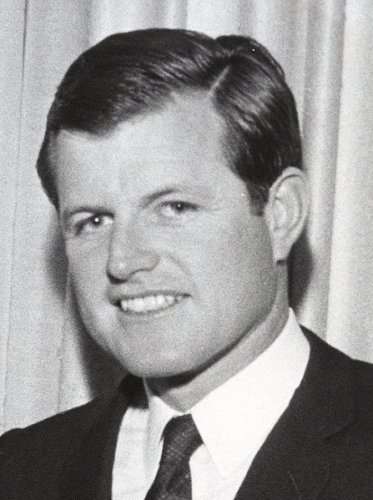Friday 18th July 1969
Shortly after leaving a party on Chappaquiddick Island, Massachusetts, Senator Edward “Ted” Kennedy drove an Oldsmobile off a wooden bridge into a tide-swept pond. Kennedy escaped the submerged car, but his passenger, 28-year-old Mary Jo Kopechne, did not. According to his own testimony, Kennedy accidentally drove his car off a one-lane bridge and into a tidal channel before swimming free, leaving the scene, and not reporting the accident for nine hours. Meanwhile, Kopechne had died in the car through drowning or suffocation. The next day, Kopechne’s body and the car were both recovered by divers. Kennedy pleaded guilty to a charge of leaving the scene of a crash after causing injury and later received a two-month suspended jail sentence. The Chappaquiddick incident became a national scandal, and likely influenced Kennedy’s decision not to campaign for President in 1972 and 1976. Senator Ted Kennedy hosted a party on Chappaquiddick, a small island connected via ferry to the town of Edgartown on the nearby larger island of Martha’s Vineyard. The party was a reunion for a group of six women, including Mary Jo Kopechne, known as the “boiler-room girls”, who had served Robert F. Kennedy’s 1968 presidential campaign. Also present were Joseph Gargan, Kennedy’s cousin; Paul F. Markham, a school friend of Gargan who previously served as the United States Attorney for Massachusetts; Charles Tretter, an attorney; Raymond La Rosa; and John Crimmins, Kennedy’s part-time driver. Kennedy was also competing in the Edgartown Yacht Club Regatta, a sailing competition which was taking place over several days. All six men were married and all six women were single, aged 28 and younger. Bobby Kennedy was Ted Kennedy’s older brother, and following Bobby’s assassination in June 1968 Ted took up his family’s political torch. In 1969, Ted Kennedy was elected majority whip in the U.S. Senate, and he seemed an early front-runner for the 1972 Democratic presidential nomination. Just after 11 p.m., Kennedy left the party with Kopechne, by his account to drive to the ferry slip where they would catch a boat back to their respective lodgings in Edgartown on Martha’s Vineyard. While driving down the main roadway, Kennedy took a sharp turn onto the unpaved Dike Road, drove for a short distance, and then missed the ramp to a narrow wooden bridge and drove into Poucha Pond. Kennedy, a married man, claimed the Dike Road excursion was a wrong turn. However, both he and Kopechne had previously driven down the same road, which led to a secluded ocean beach just beyond the bridge. In addition, Kopechne had left both her purse and room key at the party. Kennedy escaped the car and then dove down in an attempt to retrieve Kopechne from the sunken Oldsmobile. Failing, he stumbled back to the cottage, where he enlisted Gargan and another friend in a second attempt to save Kopechne. The three men were unsuccessful; her body was not recovered. The trio then went to the ferry slip, where Kennedy dove into the water and swam back to Edgartown, about a mile away. He returned to his room at the Shiretown Inn, changed his clothes, and at 2:25 a.m. stepped out of his room when he spotted the innkeeper, Russell Peachey. He told Peachey that he been awakened by noise next door and asked what time it was. He then returned to his room. Was Kennedy trying to establish an alibi? In Leo Damore’s Senatorial Privilege–the Chappaquiddick Cover-up (1988), the author recounts an interview with Joe Gargan in which Gargan claimed that Kennedy had plotted to make Kopechne the driver and sole occupant of the automobile. Whatever Kennedy’s intentions, on the morning of July 19 he went back to Chappaquiddick Island and then returned to Edgartown. At 9:45 a.m., 10 hours after driving off Dike Road bridge, Kennedy reported the accident to Edgartown Police Chief Dominick Arena and admitted that he was the driver. On July 25, Kennedy pleaded guilty to leaving the scene of an accident, received a two-month suspended sentence, and had his license suspended for a year. That evening, in a televised statement, he called the delayed reporting of the accident “indefensible” but vehemently denied that he been involved in any improprieties with Kopechne. He also asked his constituents to help him decide whether to continue his political career. Receiving a positive response, he resumed his senatorial duties at the end of a month. There is speculation that he used his considerable influence to avoid more serious charges that could have resulted from the episode. Although the incident on Chappaquiddick Island helped to derail his presidential hopes, Kennedy continued to serve as a U.S. senator of Massachusetts into the 21st century.






